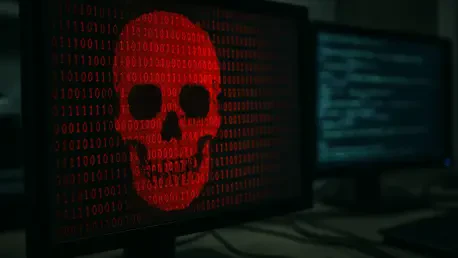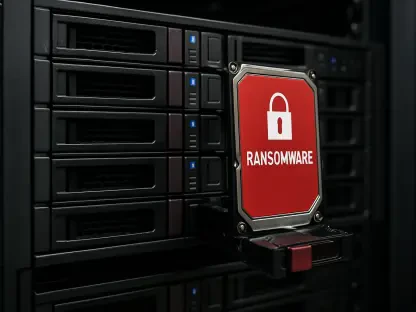In the fast-paced realm of cybersecurity, a severe vulnerability in Microsoft SharePoint, dubbed “ToolShell,” has surfaced as a significant danger to organizations across the globe, exposing critical weaknesses in a platform relied upon by countless enterprises and government bodies. Discovered during an ethical hacking competition in May 2024, this zero-day flaw has been under active exploitation since early July 2024, primarily targeting on-premises SharePoint systems. Hackers have seized this opportunity to infiltrate networks, deploying destructive ransomware and jeopardizing sensitive data and operational stability. Despite Microsoft’s efforts to roll out patches, the rapid and sophisticated nature of these attacks has left numerous systems exposed. This article explores the intricacies of the flaw, the tactics employed by malicious actors, and the pressing measures required to curb the escalating damage.
SharePoint, a cornerstone for collaboration and document management in many organizations, has become a focal point for cyberattacks due to its widespread adoption and the critical data it often holds. The ToolShell vulnerability, which combines an authentication bypass with an insecure deserialization issue, provides attackers with a potent gateway into protected systems. Recent scans reveal that at least 400 out of 23,000 SharePoint servers have already fallen victim to these exploits, with US government agencies among the affected. The widespread impact, compounded by the involvement of varied hacking groups, underscores the urgency of addressing this threat. As unpatched systems remain highly susceptible, gaining insight into the exploitation methods is essential for organizations striving to safeguard their digital assets.
Unpacking the SharePoint Vulnerability
Decoding the Technical Weakness
The ToolShell flaw represents a critical zero-day vulnerability within Microsoft SharePoint, enabling attackers to sidestep authentication protocols and exploit an insecure deserialization bug. First uncovered in May 2024 during a hacking competition, evidence of active exploitation emerged by July 7, 2024, highlighting the alarming speed at which cybercriminals capitalize on such discoveries. This vulnerability predominantly impacts on-premises SharePoint installations, offering hackers a direct route to penetrate organizational networks. The combination of bypassing security checks and manipulating data deserialization creates a severe risk, allowing unauthorized access to sensitive information and system controls. Microsoft has acknowledged the gravity of this issue, emphasizing that the flaw’s exploitation can lead to full system compromise if not addressed promptly. Organizations relying on SharePoint must recognize the technical underpinnings of this threat to implement effective countermeasures.
Understanding the broader implications of the ToolShell flaw requires examining its potential to cascade through interconnected systems. Once attackers gain entry, they can move laterally within a network, exploiting additional vulnerabilities or accessing linked databases and applications. The initial breach, often unnoticed due to the stealthy nature of authentication bypass, can remain undetected for extended periods, giving hackers ample time to extract data or prepare further attacks. Reports indicate that the flaw affects multiple versions of SharePoint, including older deployments that may lack robust monitoring. This widespread susceptibility amplifies the challenge for IT teams, who must not only patch systems but also audit for signs of prior compromise. The technical complexity of deserialization exploits means that standard security tools might fail to detect malicious activity, necessitating specialized defenses and heightened vigilance to protect critical infrastructure.
Scope and Scale of the Impact
The reach of the ToolShell vulnerability is staggering, with early data revealing that hundreds of SharePoint servers have already been breached, out of tens of thousands scanned globally. Notably, US government entities have been among the primary targets, signaling the strategic importance of the systems compromised. Eye Security, an organization monitoring the threat, reported that at least 400 servers were affected as of the latest updates, though the true number may be higher due to underreporting or undetected breaches. The focus on high-value targets like governmental systems suggests that attackers are prioritizing entities with sensitive data or critical operations. Microsoft has issued stark warnings that unpatched systems face ongoing risks, predicting a surge in attacks until comprehensive mitigation is achieved. This widespread impact illustrates the urgent need for organizations to assess their exposure and act decisively.
Beyond the raw numbers, the ripple effects of these breaches are profound, disrupting not just individual organizations but also supply chains and public services reliant on SharePoint. Compromised servers often host collaborative projects, financial records, or proprietary information, meaning a single breach can have far-reaching consequences. For government agencies, the stakes are even higher, as stolen data could compromise national security or public trust. The global nature of SharePoint’s user base means that attackers can exploit regional differences in patch adoption, targeting less-prepared entities. Additionally, the financial cost of recovery—ranging from ransom payments to system restoration—can be crippling, especially for smaller organizations lacking robust cybersecurity budgets. This crisis underscores the importance of proactive defense strategies and international cooperation to combat a threat that transcends borders and sectors.
Exploitation Strategies and Key Actors
Ransomware Campaigns by Storm-2603
Among the most troubling developments tied to the ToolShell flaw is its exploitation for ransomware attacks by a group identified as Storm-2603. This hacking collective has been deploying malicious payloads such as Warlock and Lockbit, using the SharePoint vulnerability as an entry point to infiltrate systems. Their approach is particularly destructive, often involving the theft of critical data like MachineKeys before encrypting networks and demanding hefty ransoms for decryption keys. This dual tactic of data exfiltration and system lockdown maximizes the pressure on victims, forcing difficult decisions between paying ransoms or facing prolonged downtime. Microsoft has flagged Storm-2603 as a significant threat, noting their focus on high-impact targets to extract maximum financial gain. The use of ransomware through this flaw highlights a dangerous escalation in cybercrime tactics that organizations must counter with urgency.
The sophistication of Storm-2603’s operations adds another layer of concern for cybersecurity professionals tasked with defending against these threats. Beyond simply deploying ransomware, the group exhibits a strategic understanding of enterprise environments, targeting SharePoint servers that often serve as central hubs for sensitive operations. Their ability to steal MachineKeys—a critical component for system authentication—before encryption suggests a calculated effort to retain long-term access or leverage stolen credentials for future attacks. This multi-stage attack model complicates recovery efforts, as organizations must address both immediate system restoration and the potential misuse of exfiltrated data. The financial motivation driving Storm-2603, combined with their exploitation of a zero-day flaw, serves as a stark reminder of the evolving nature of cyber threats, where profit-driven actors continuously adapt to exploit the latest vulnerabilities.
Involvement of State-Sponsored Actors
In addition to criminal enterprises like Storm-2603, the ToolShell vulnerability has attracted the attention of state-sponsored hacking groups, including Chinese entities known as Linen Typhoon and Violet Typhoon. These actors have reportedly leveraged the flaw to target government institutions, likely for espionage or to disrupt critical operations as part of broader geopolitical strategies. Unlike ransomware gangs focused on financial gain, state-backed groups often prioritize stealing classified information or creating chaos within strategic sectors. Microsoft has noted the involvement of such actors, though definitive attribution remains complex due to the opaque nature of cyber operations. The targeting of high-profile entities underscores the vulnerability’s appeal as a tool for achieving national interests, blending traditional cybercrime with statecraft in a way that challenges conventional defense mechanisms.
The implications of state-sponsored exploitation extend far beyond immediate data breaches, raising concerns about long-term security and international relations. When groups like Linen Typhoon or Violet Typhoon exploit flaws like ToolShell, their actions can erode trust in digital infrastructure, prompting governments to reevaluate their reliance on platforms like SharePoint for sensitive communications. The potential for stolen data to be used in future operations—whether for blackmail, propaganda, or further cyberattacks—adds a chilling dimension to these incidents. Moreover, the overlap between state and criminal actors, where ransomware might serve as a cover for espionage, complicates efforts to categorize and respond to threats. This convergence of motives illustrates a shifting cyber landscape, where defending against a single flaw requires addressing a spectrum of adversaries with diverse objectives, from monetary gain to geopolitical disruption.
Navigating the Aftermath and Future Safeguards
Lessons from Microsoft’s Response
Reflecting on the response to the ToolShell vulnerability, Microsoft’s initial efforts to patch the flaw on July 8, 2024, were quickly undermined as hackers bypassed the fix within ten days, exposing gaps in the early mitigation strategy. Subsequent updates expanded protection to all supported SharePoint versions, including 2016 and 2019, alongside recommendations to enable tools like Antimalware Scan Interface and Microsoft Defender Antivirus. However, criticism from industry experts, such as Kevin Robertson, CTO at Acumen Cyber, pointed to perceived negligence in the initial rollout, arguing that such oversights left organizations exposed during a critical window. This episode revealed the challenges software vendors face in delivering timely and effective fixes against rapidly evolving threats, prompting a reevaluation of how updates are tested and deployed to prevent similar lapses in the future.
The broader takeaway from Microsoft’s handling of this crisis lies in the need for transparency and speed in addressing zero-day flaws. The delay between the initial patch and its bypass allowed attackers to exploit vulnerabilities at scale, underscoring the importance of rigorous pre-release testing and clear communication with users about interim protective measures. Organizations that delayed patching due to operational constraints or lack of awareness faced heightened risks, a situation that could have been mitigated with more proactive guidance from the vendor. Microsoft’s eventual comprehensive updates and ongoing threat intelligence sharing set a positive precedent, but the initial stumble serves as a cautionary tale. This experience emphasized that vendors must anticipate adaptive adversaries and prioritize robust, immediate solutions to safeguard users against the relentless pace of cyber exploitation.
Building Resilient Defenses Moving Forward
Looking back at the fallout from the ToolShell flaw, the cybersecurity community rallied to advocate for stronger, proactive measures to prevent the recurrence of such widespread breaches. Organizations were urged to prioritize immediate patching of all SharePoint systems, coupled with layered security approaches to detect and block unauthorized access. Beyond technical fixes, there was a push for enhanced training to ensure IT teams could recognize early signs of compromise and respond swiftly. Collaboration between public and private sectors emerged as a critical step, with shared threat intelligence helping to identify and neutralize exploiting actors. The urgency to address unpatched systems remained a focal point, as experts predicted continued attacks until full mitigation was achieved across vulnerable environments.
Reflecting on the path ahead, the incident served as a catalyst for rethinking enterprise software security at a systemic level. Cybersecurity leaders called for automated patch management systems to reduce human error and accelerate update deployment, alongside regular audits to identify outdated or misconfigured systems. Investment in advanced threat detection tools became a priority, as did fostering a culture of security awareness within organizations to minimize insider risks. Governments and industry bodies were encouraged to establish stricter standards for software vendors, ensuring accountability for timely and effective responses to vulnerabilities. The legacy of this crisis was a renewed commitment to resilience, with the understanding that defending against sophisticated threats requires not just reaction, but anticipation and continuous improvement in safeguarding digital ecosystems.









